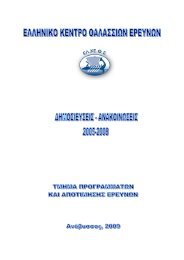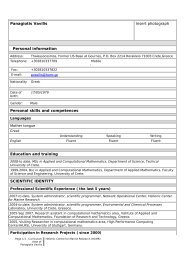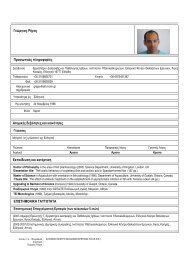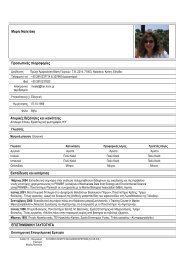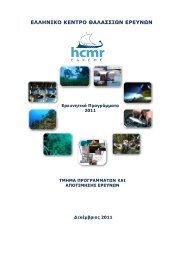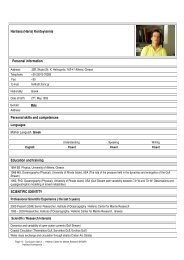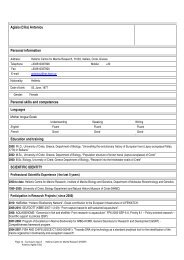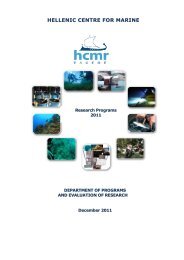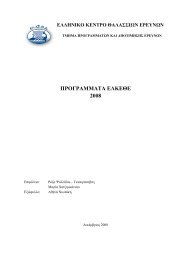2009 Research Programmes of the HCMR - Hellenic Centre for ...
2009 Research Programmes of the HCMR - Hellenic Centre for ...
2009 Research Programmes of the HCMR - Hellenic Centre for ...
Create successful ePaper yourself
Turn your PDF publications into a flip-book with our unique Google optimized e-Paper software.
Brief Description <strong>of</strong> <strong>the</strong> Program: MarinERA is a partnership <strong>of</strong> <strong>the</strong> leading Marine RTD<br />
Funding Organizations from 13 European Member States, supported by <strong>the</strong> Marine Board <strong>of</strong><br />
European Science Foundation (MB-ESF). Toge<strong>the</strong>r, <strong>the</strong>se Funding Agencies represent an<br />
investment <strong>of</strong> circa € 100 million/annum in marine research. In addition, amongst a range <strong>of</strong><br />
Advisory Members, five international networks <strong>of</strong> research organizations (BONUS, EFARO,<br />
EuroGOOS, European Polar Board, IACMST), and international organization (OICES) and two<br />
fur<strong>the</strong>r Member State funding agencies have associated <strong>the</strong>mselves with <strong>the</strong> project.<br />
The MarinERA project will: (1) Map European marine RTD programmes and specialized<br />
infrastructures to contribute towards <strong>the</strong> development <strong>of</strong> <strong>the</strong> marine element <strong>of</strong> <strong>the</strong> European<br />
<strong>Research</strong> Area, facilitating <strong>the</strong> creation <strong>of</strong> an internal market and quantifying <strong>the</strong> existing European<br />
marine research capacity. (2) Facilitate <strong>the</strong> networking <strong>of</strong> Marine RTD Funding Agencies in <strong>the</strong><br />
European Union, leading to a more cost effective and efficient use <strong>of</strong> Member State resources<br />
including scientific personnel, specialist infrastructures and planned investments. (3) Contribute to<br />
<strong>the</strong> development <strong>of</strong> a European Marine <strong>Research</strong> Policy, identifying future challenges and<br />
opportunities and <strong>the</strong> priority research programmes that need to be put in place to address/ benefit<br />
from <strong>the</strong>m. (4) Provide a basis <strong>for</strong> sharing available resources to address priority issues which are<br />
beyond <strong>the</strong> capacities <strong>of</strong> individual member States. (5) Progress <strong>the</strong> reciprocal opening <strong>of</strong> Member<br />
State Marine RTD <strong>Programmes</strong>, which has been identifies as a key objective <strong>of</strong> <strong>the</strong> ERA.<br />
Design study <strong>for</strong> a Deep Sea Facility in <strong>the</strong> Mediterranean <strong>for</strong> Neutrino Astronomy and<br />
Associated Sciences (Km3Net/ 594). *<br />
Contract Number: GOCE-CT-2006-011937<br />
Scientific Coordinator: Dr V. Lykoussis<br />
Funding: EU (50%) & GSRT (50%)<br />
Starting Year: 2006<br />
Duration: 45 months (01/02/06-31/10/09)<br />
Total Budget: 802.400 €<br />
Study Area:<br />
Capo Passero, Toulon, Pylos.<br />
Scientific team (ΗCMR): Dr V. Lykousis, Dr E. Balopoulos, Dr D. Sakellariou, M. Alexandri, Dr<br />
A. Karageorgis, Dr H. Kodogiannis, Dr I. Papoulia, Dr N. Lambadariou, Dr P. Polymenakou, Dr I.<br />
Siokou, Dr A. Pavlidou, A. Asimakopoulou, S. Stavrakakis, Dr T. Alves, V. Papadopoulos, G.<br />
Rousakis, P. Georgiou, Dr P. Nomikou, Dr H. Kaberi, P. Mandopoulos, I. Pambidis, D. Balas, P.<br />
Renieris, G. Pappas, A. Morfis.<br />
O<strong>the</strong>r participants: (1) University <strong>of</strong> Pireus, Pr<strong>of</strong>. A. Tselepidis (till 29/03/06), (2) University <strong>of</strong><br />
Erlangen (Overall project coordinator) & 24 partners.<br />
Brief Description <strong>of</strong> <strong>the</strong> Program: The primary objectives <strong>of</strong> <strong>the</strong> KM3NeT Design Study are <strong>the</strong><br />
development <strong>of</strong> a cost-effective design <strong>for</strong> a cubic-kilometre sized deep-sea infrastructure housing a<br />
neutrino telescope with unprecedented physics sensitivity and providing long-term access <strong>for</strong> deepsea<br />
research, <strong>the</strong> evaluation <strong>of</strong> procedures <strong>for</strong> <strong>the</strong> assembly and construction <strong>of</strong> <strong>the</strong> infrastructure<br />
and <strong>the</strong> preparation <strong>of</strong> models <strong>for</strong> its operation and maintenance.<br />
General conditions: The combination <strong>of</strong> <strong>the</strong> relatively low flux <strong>of</strong> high energy cosmic neutrinos and<br />
<strong>the</strong>ir weak interaction with matter implies <strong>the</strong> need <strong>for</strong> a very massive detector (1012 kg, i.e. a<br />
cubic kilometre <strong>of</strong> water). The solution pursued is to instrument a large volume <strong>of</strong> deep-sea water<br />
with a three-dimensional array <strong>of</strong> photo-sensors (photomultiplier tubes, PMTs) detecting <strong>the</strong><br />
Cerenkov light produced by charged particles emerging from neutrino interactions in <strong>the</strong> water or<br />
sea bed. In order to suppress daylight and background from muons produced in cosmic ray<br />
interactions in <strong>the</strong> Earth's atmosphere, <strong>the</strong> telescope must be operated at depths <strong>of</strong> several<br />
kilometres. In seawater, irreducible background light is emitted by decays <strong>of</strong> 40K nuclei and by<br />
bioactivity, and environmental processes such as sedimentation or bio-fouling affect <strong>the</strong> long-term<br />
17



